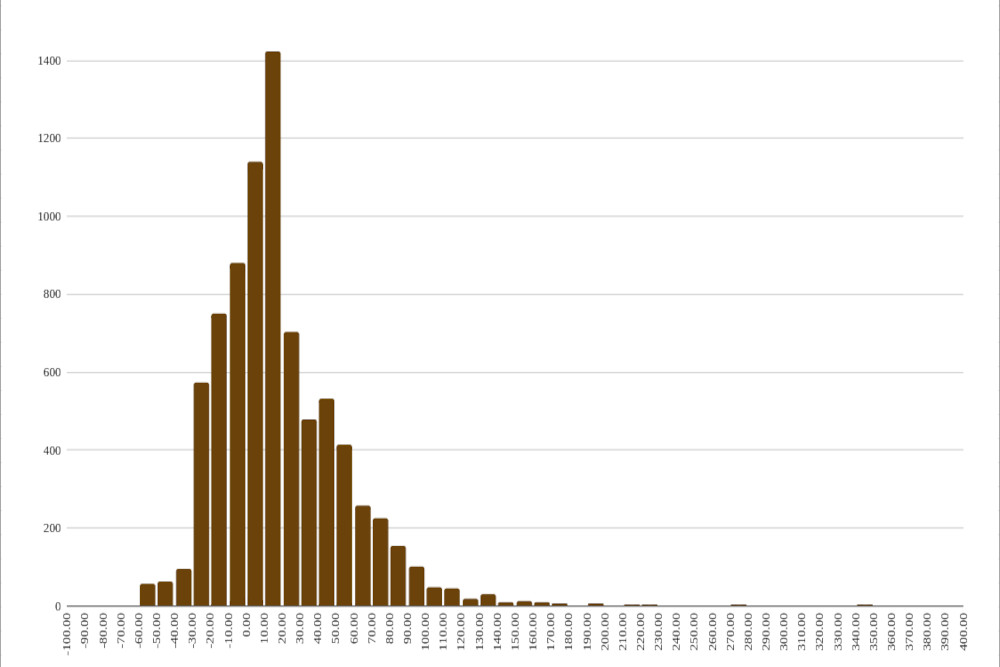TRADING & INVESTING STRATEGIES
Online Course
REGISTER NOW
Over 36 years of sensex daily closings analysed (up to 30 Sept 2022)
Posted: Oct 10, 2022 00:30
SHARE
The sensex was published on January 1, 1986 (Wikipedia), and back-calculated index values from 1979 were also released with it.
For this study we will take figures only from 1986, as there would be a recency bias in the choice of stocks in the index.
(You can click on all the underlined terms in this piece to get more information on what they mean).
All the statistics in this post were computed using Google Sheets, which is like Excel running in your browser. However, its superpower is its ability to load price data directly into a spreadsheet. Investors not using Google Sheets are missing out!
The spreadsheet used to create the statistics on this page is one of many you will receive in the Trading and Investing Strategies online course. You can use it to make similar calculations for stocks, indices, mutual funds and currencies across all major countries by simply changing the id. It even works for crypto!
Participants will own a powerful toolkit of Google Sheets for doing Momentum Investing, risk-reward analysis for stocks as well as indices and MFs, Day-trading, Risk & Money Management, Technical analysis indicators, Options valuation, and several more. They also learn how to master Google Sheets and create such spreadsheets with ease.
You can find more information about the course here : Trading and Investing Strategies - content and structure. The course is self-paced, and suitable for absolute beginners and experienced traders alike. It is completely different from conventional courses.
Daily data from Jan 2, 1986 (the first trading day that year) to Sept 30, 2022 has been taken, giving us 8,711 trading days.
The average daily YOY (Year-Over-Year) returns for the sensex between these dates is 17.34%. Computation starts from Jan 2, 1987 - which is one year from the start of the data.
The sensex was 549.43 on Jan 2, 1986, and 57,426.92 on Sept 30, 2022, giving it a CAGR (Compound Annual Growth Rate) of 13.49% over 36 years and 272 days.
The highest YOY return was 266.88% between Mar 27, 1991 and Mar 31, 1992. The worst YOY return was -56.45% betweem Jan 11, 2008 and Jan 13, 2009.
We have 8,514 trading days for which the YOY returns were computed. Of these 5,911 (69.43%) days gave positive returns, and 2,603 (30.57%) gave negative (or zero) returns. The standard deviation of these returns is 33.09%. The YOY return on Sept 30, 2022 stood at -2.87%.
Apart from all the YOY statistics, the daily return data is also interesting. This computation starts from 1986 itself, as we do not have to wait a year for the YOY returns.
The average daily return for the sensex from Jan 3, 1986 to Nov 18, 2021 is +0.0666%. That is the arithmetic mean (AM). The Geometric Mean (GM) is +0.0534%. The GM is always less than the AM, unless all data points are identical, in which case they are the same.
When compounding returns, we must use the GM and not the AM. For instance, you can actually use the GM to get the Sept 30, 2022 closing from the Jan 2, 1986 one :
57426.92 = 549.43 * (1.000534) ^ 8710..
57426.92 is the sensex's Sept 30, 2022 closing, 549.43 is that on Jan 2, 1986, 1.000534 is (1 + GM) for getting the multiplier for a single day. The operator ^ is "to the power of", and 8710 is the number of days of data. (You will need a few more decimal places in the GM to get the precise value).
The standard deviation of the daily returns is 1.6289%. The range between the average daily return plus and minus three standard deviations is -4.82% and +4.95%. If this were a Normal Distribution then we would expect 99.73% of the daily returns to be inside those two percentages. This would mean that we should not find more than 24 days where the sensex fell more than 4.82% or gained over 4.95%. However, there are 132 such points, the reason such distributions are said to have fat tails.
The largest single day gain was 20.80% on Mar 2, 1992 (11.8 standard deviations). There are five single day gains in excess of 10%.
The largest single day loss was 13.15% on Mar 23, 2020 (9.1 standard deviations). There are four single day losses in excess of 10%.
More stories about:
Investing
Markets
Blog